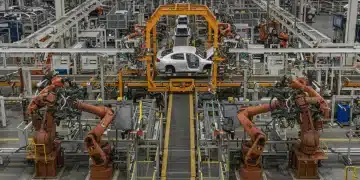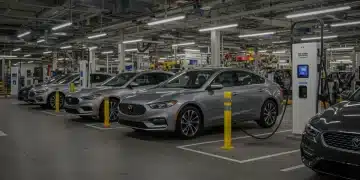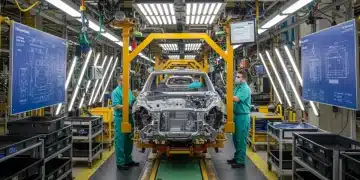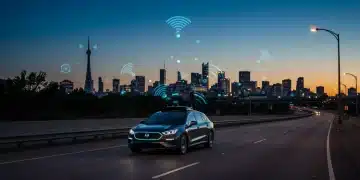Economic Impact of Autonomous Vehicle Legislation US 2025 Outlook
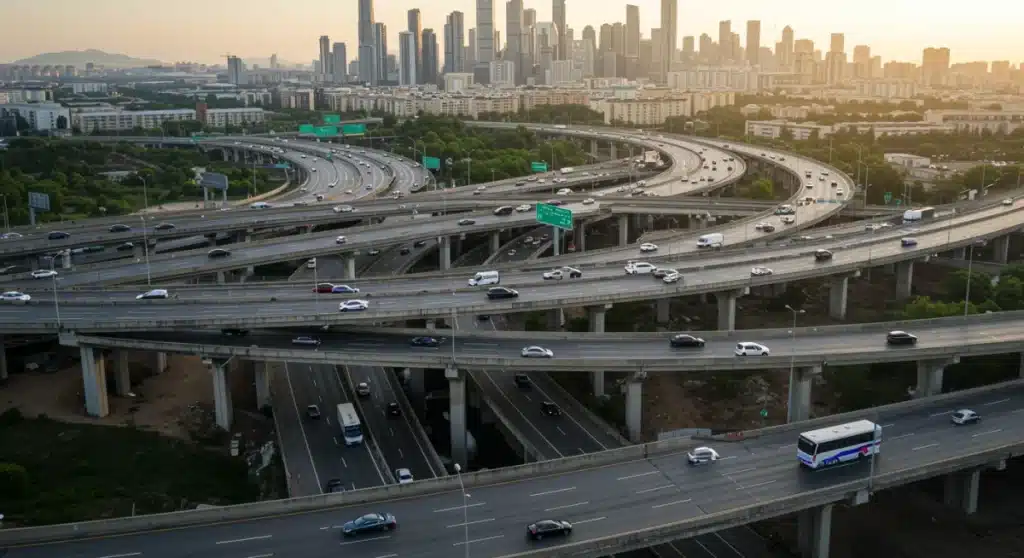
The economic impact of autonomous vehicle legislation in the US by 2025 is poised to reshape industries, create new job markets, and necessitate significant infrastructure investment.
The rapid advancement of self-driving technology has placed autonomous vehicles at the forefront of innovation, promising to revolutionize transportation. As of late 2024, the United States is grappling with fragmented regulatory frameworks, but a clearer picture for 2025 is emerging. Understanding The Economic Impact of Autonomous Vehicle Legislation in the US: A 2025 Outlook is crucial for businesses, policymakers, and the public alike, as these legislative decisions will profoundly influence job markets, infrastructure development, and overall economic growth.
Navigating the Legislative Landscape for Autonomous Vehicles
The current legislative environment for autonomous vehicles (AVs) in the U.S. remains a patchwork of state-level regulations, creating significant challenges for manufacturers and operators. This fragmentation impedes nationwide deployment and complicates the economic projections for 2025. However, there’s increasing pressure for federal guidelines to streamline development and foster a more unified market. Efforts are underway to bridge these gaps, with various stakeholders advocating for a comprehensive national framework.
Recent discussions in Congress highlight a growing recognition of the need for federal intervention. Lawmakers are exploring ways to ensure safety, promote innovation, and address liability concerns, all while fostering economic growth. The goal is to create a predictable regulatory environment that encourages investment and accelerates the adoption of AV technology across different sectors.
State-Level Initiatives and Their Economic Implications
Several states have taken proactive steps to establish their own AV testing and deployment regulations. These early adopters often see an influx of research and development investment, creating localized economic booms. For instance, states like Arizona and California have become hubs for AV testing, attracting major tech and automotive companies. This has led to job creation in engineering, software development, and technical support roles.
- Arizona’s Open-Door Policy: Attracted numerous AV companies, fostering a tech ecosystem.
- California’s Stringent Testing: Ensures safety and builds public trust, albeit with slower deployment.
- Michigan’s Automotive Heritage: Leverages existing infrastructure for AV R&D and manufacturing.
These varied state approaches, while beneficial locally, underscore the broader challenge of scaling AV operations nationally. Companies face the daunting task of adapting their technology and business models to comply with differing rules, which can increase operational costs and slow down market entry. A harmonized federal approach would likely unlock greater economic efficiencies and accelerate widespread adoption.
Projected Job Market Shifts by 2025
The advent of autonomous vehicles is set to trigger significant transformations within the U.S. job market by 2025. While concerns about job displacement in the transportation sector are valid, new opportunities in manufacturing, technology, and service industries are also expected to emerge. This shift necessitates proactive workforce development and retraining initiatives to ensure a smooth transition for affected workers.
Analysts predict a net positive impact on overall employment in the long run, though specific sectors will experience considerable upheaval. The demand for skilled professionals in areas like artificial intelligence, cybersecurity, and robotics will surge, creating a new wave of high-tech jobs. Simultaneously, roles traditionally requiring human drivers, such as long-haul trucking and taxi services, will undergo substantial changes.
New Skill Demands and Workforce Retraining
The evolving landscape of autonomous transportation will place a premium on a new set of skills. Software developers, data scientists, and AI specialists will be in high demand to design, develop, and maintain AV systems. Furthermore, technicians capable of servicing complex robotic components and advanced sensor arrays will become indispensable. This shift highlights the urgent need for robust educational programs and vocational training.
- Software Engineering: Developing algorithms for navigation and decision-making.
- Cybersecurity Experts: Protecting AVs from hacking and data breaches.
- Robotics Technicians: Maintaining and repairing autonomous vehicle hardware.
Government agencies and private companies are beginning to invest in retraining programs to equip the existing workforce with these new skills. Partnerships between educational institutions and industry leaders are critical to address the impending skill gap. The success of these initiatives will largely determine the economic resilience of communities heavily reliant on traditional transportation jobs.
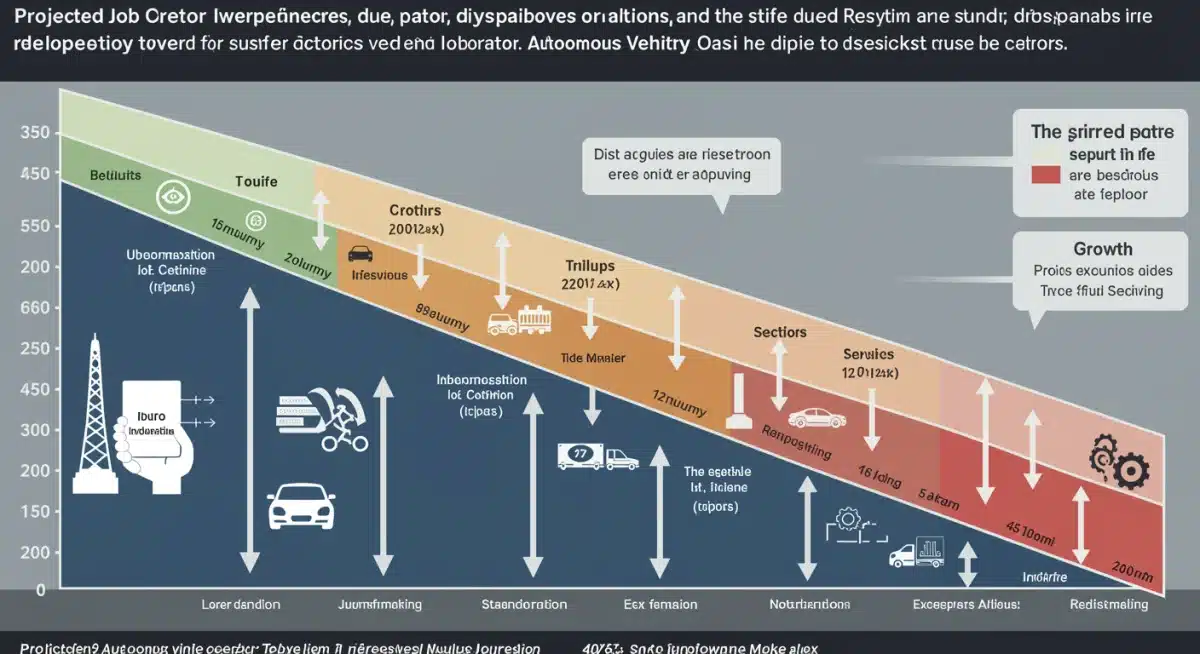
Infrastructure Investment and Development
The widespread deployment of autonomous vehicles by 2025 will necessitate substantial investments in smart infrastructure. Roads, communication networks, and charging stations will all require upgrades to support the seamless operation of AVs. This infrastructure overhaul represents a significant economic opportunity, creating jobs in construction, engineering, and technology deployment, while also enhancing overall transportation efficiency.
Smart infrastructure includes vehicle-to-everything (V2X) communication systems, advanced traffic management solutions, and dedicated lanes for AVs. These improvements are crucial for optimizing traffic flow, reducing congestion, and improving safety. The economic benefits extend beyond direct job creation, leading to reduced travel times, lower fuel consumption, and decreased accident rates, all contributing to increased productivity and economic output.
The Role of Public-Private Partnerships
Funding these extensive infrastructure projects will largely depend on innovative public-private partnerships. Governments at federal, state, and local levels will need to collaborate with private sector companies, including tech firms, automotive manufacturers, and construction companies. These collaborations can leverage private capital and expertise, accelerating the pace of development and ensuring that infrastructure meets the evolving demands of AV technology.
- Smart Road Sensors: Real-time data collection for traffic optimization.
- 5G Network Expansion: Essential for reliable V2X communication.
- Electric Vehicle Charging Infrastructure: Supporting the growing fleet of electric AVs.
The strategic allocation of funds and resources will be paramount. Prioritizing critical corridors and urban areas with high AV adoption potential can maximize the immediate economic returns. Furthermore, developing standardized protocols for V2X communication and data sharing will ensure interoperability and efficiency across different AV platforms and infrastructure components.
Impact on Logistics and Supply Chain Efficiency
Autonomous vehicle legislation in the US by 2025 is set to profoundly impact the logistics and supply chain sectors, promising unprecedented levels of efficiency and cost reduction. The deployment of self-driving trucks and delivery vehicles will revolutionize how goods are transported, leading to faster delivery times, optimized routes, and a significant decrease in operational expenses. This transformation will ripple through the entire economy, benefiting businesses and consumers alike.
The ability of AVs to operate continuously without human fatigue limits will enable 24/7 transportation, drastically cutting transit times. Furthermore, advanced AI-driven routing systems will minimize fuel consumption and congestion, contributing to both economic savings and environmental benefits. This enhanced efficiency will make supply chains more resilient and responsive to market demands.
Cost Reductions and Operational Advantages
One of the most significant economic advantages of autonomous logistics is the reduction in labor costs. While this will lead to job displacement for some drivers, it will free up capital for companies to invest in other areas, such as technology development, infrastructure, and new service offerings. Additionally, the precision and consistency of AV operations are expected to reduce accidents and insurance premiums, further lowering operational costs.
Autonomous delivery services, particularly in urban areas, will also see a boost. Drones and smaller self-driving robots can handle last-mile deliveries more efficiently, reducing traffic and pollution in city centers. This localized efficiency will create new business models and opportunities for on-demand services, catering to the evolving expectations of consumers.
Insurance and Liability Frameworks for AVs
The legal and economic implications of autonomous vehicle accidents are a critical area of focus for legislation impacting the US by 2025. Establishing clear insurance and liability frameworks is essential for the widespread adoption of AVs. Traditional models, which typically assign fault to a human driver, are inadequate for self-driving cars, necessitating a complete re-evaluation of current legal doctrines and insurance policies.
Policymakers are working to define who is responsible when an autonomous vehicle is involved in a collision – the manufacturer, the software developer, the vehicle owner, or the operator. This clarification is vital for building public trust and ensuring that victims of AV accidents are adequately compensated. The economic stability of the AV industry hinges on these frameworks being robust and equitable.
Evolving Insurance Models and Premiums
The insurance industry is actively developing new models to address the unique risks associated with autonomous vehicles. These models may shift focus from driver behavior to vehicle technology and software performance. Data collected from AVs, such as sensor readings and operational logs, will play a crucial role in determining fault and assessing risk. This data-driven approach could lead to more accurate premium calculations and potentially lower overall insurance costs as AV safety improves.
- Product Liability: Manufacturers may bear more responsibility for software or hardware failures.
- Cybersecurity Insurance: New policies to cover risks associated with hacking or data breaches.
- Fleet Insurance: Specialized policies for companies operating large fleets of AVs.
The transition to these new insurance frameworks will require close collaboration between government regulators, automotive companies, and insurance providers. Establishing clear standards and guidelines will provide the necessary certainty for both consumers and businesses, fostering a more stable and predictable economic environment for the autonomous vehicle sector.
Consumer Adoption and Market Dynamics by 2025
The rate of consumer adoption of autonomous vehicles will be a pivotal factor in shaping The Economic Impact of Autonomous Vehicle Legislation in the US: A 2025 Outlook. Public perception, trust, and affordability will dictate how quickly these technologies integrate into daily life. While early adopters are already embracing limited self-driving features, widespread acceptance of fully autonomous vehicles will depend on several key factors, including safety records, regulatory clarity, and compelling economic benefits for consumers.
Legislation plays a crucial role in building consumer confidence. Clear rules regarding safety standards, data privacy, and liability will reassure potential buyers and users. As regulations become more harmonized and transparent, the perceived risks associated with AVs will diminish, paving the way for broader market penetration. The economic benefits for consumers, such as reduced transportation costs and increased personal time, will also drive adoption.
Shifting Car Ownership Models
The rise of autonomous vehicles may also accelerate a shift away from traditional car ownership towards shared mobility services. Ride-hailing and subscription models for AVs could become increasingly popular, particularly in urban areas. This shift has significant economic implications for the automotive industry, urban planning, and related service sectors.
- Reduced Personal Vehicle Ownership: Leading to lower demand for parking spaces and personal car maintenance.
- Growth of Mobility-as-a-Service (MaaS): New business models centered around shared autonomous fleets.
- Increased Accessibility: Providing transportation options for individuals unable to drive, expanding economic participation.
The economic impact of this shift will include changes in vehicle sales, increased demand for fleet management services, and new opportunities in urban infrastructure adaptation. Businesses that can adapt to these evolving consumer preferences and provide innovative AV-based mobility solutions are poised for significant growth in the coming years.
Investment Trends and Economic Growth
By 2025, the economic landscape surrounding autonomous vehicles in the US is expected to see robust investment trends, driving significant economic growth. Venture capital, corporate R&D, and government grants are all pouring into the AV sector, reflecting confidence in its future potential. This influx of capital is fueling innovation, accelerating technological development, and creating a dynamic ecosystem of startups and established players.
The promise of substantial returns from a transformed transportation sector is attracting investors globally. Beyond direct investment in AV technology, there’s also significant capital flowing into complementary industries, such as advanced sensor manufacturing, AI development, and cybersecurity solutions. This broad investment base underscores the multifaceted economic opportunities presented by autonomous vehicles.
Emerging Market Opportunities and Spin-offs
The development and deployment of autonomous vehicles are creating numerous spin-off industries and market opportunities. These include specialized software for mapping and navigation, advanced materials for vehicle construction, and new forms of in-vehicle entertainment and productivity services. Each of these areas represents a potential growth engine for the U.S. economy.
- Data Monetization: Utilizing data from AVs for urban planning and traffic management.
- Cybersecurity Solutions: Protecting AV systems from evolving digital threats.
- Advanced Sensor Technology: Innovations in LiDAR, radar, and camera systems.
The economic growth generated by the AV sector is not limited to direct employment and investment. It also includes productivity gains across various industries due to more efficient logistics, reduced traffic congestion, and safer roads. These indirect benefits contribute significantly to overall national economic prosperity, making autonomous vehicle legislation a key driver of future economic expansion.
| Key Economic Aspect | 2025 Outlook |
|---|---|
| Job Market | Shifts from traditional roles to high-tech positions (AI, cybersecurity, robotics), requiring significant retraining programs. |
| Infrastructure Investment | Substantial spending on smart roads, V2X communication, and charging networks, driven by public-private partnerships. |
| Supply Chain Efficiency | Reduced operational costs, faster deliveries, and optimized logistics through autonomous trucking and last-mile solutions. |
| Investment & Growth | Robust venture capital and corporate R&D, fostering innovation and creating new market opportunities in related tech sectors. |
Frequently Asked Questions About Autonomous Vehicle Economics
By 2025, autonomous vehicle legislation will likely accelerate job displacement in sectors like long-haul trucking and ride-sharing. However, new jobs in AV development, maintenance, and data management are expected to emerge, necessitating significant workforce retraining and skill adaptation programs.
By 2025, legislation will drive increased investment in smart infrastructure, including V2X communication systems, enhanced digital mapping, and electric vehicle charging stations. These upgrades are crucial for supporting AV deployment, improving traffic flow, and ensuring safe autonomous operations across the US.
By 2025, AV legislation will necessitate new insurance models shifting liability from human drivers to manufacturers or software providers. This could lead to specialized policies covering product liability and cybersecurity, potentially altering premium structures as AV safety data becomes more robust and reliable.
By 2025, AV legislation is expected to significantly enhance logistics and supply chain efficiency. This includes reduced labor costs, faster delivery times due to 24/7 operation, optimized routing, and fewer accidents, leading to substantial cost savings and increased productivity across various industries.
Legislation by 2025 will significantly influence consumer adoption by establishing clear safety standards, liability rules, and data privacy protections. These measures are vital for building public trust and confidence in AV technology, encouraging wider acceptance and potentially accelerating the shift towards shared mobility services.
What Happens Next
As 2025 approaches, the momentum towards a more cohesive federal approach to autonomous vehicle legislation is undeniable. Stakeholders anticipate continued legislative efforts to harmonize state-specific rules, which will be critical for unlocking the full economic potential of AV technology. Businesses should prepare for evolving regulatory landscapes, while policymakers will focus on balancing innovation with safety and addressing societal impacts like job transitions. The coming year will be pivotal in shaping the long-term trajectory of autonomous transportation and its profound economic implications across the United States.


